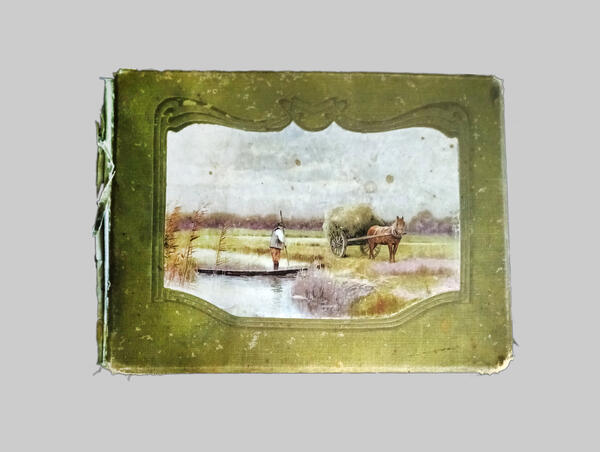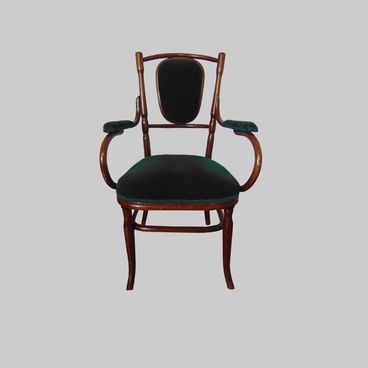In the early twentieth century, photo albums were often used as interior decoration in noble households. The Aksakov family was no exception. They kept this photo album in one of the living rooms of their houses. It is firmly bound in a hardcover, with a total of 24 sheets, each of which has a photo slit. The size of the slits is different so that it is possible to place images of different sizes in the album. On the cover of it there is an image of a village scene. In the foreground to the right of the center you can see a horse-drawn carriage with hay, and to the left a peasant on a boat pulls up to the shore. The sky in the picture on the album cover is gloomy, promising an imminent rain.
This photo album is of a smaller size, its width being only 11.5 cm. Such photo albums in the late 19th and early 20th centuries were often left in the rooms where guests were accommodated so that they could occupy themselves with something. That’s why in the sitting room of the Aksakovs family museum the photo album is displayed on an elegant wooden bookcase in Thonet style: a visitor there could take the album and look through it while waiting for someone. Given the number of outstanding people among the Aksakovs, it’s not surprising that they regularly had guests.
According to one theory, the old noble lineage of the Aksakovs originates from the renowned Varangian, Shimon Afrikanovich, who came to Kiev in the early 10th century. Some sources link it to the foundation of the Kiev Pechersk Lavra, to the construction of which he made generous donations. However, in addition to the Aksakovs, numerous Russian noble families claimed to be descendants of this Varangian.
As early as in the 19th century, Sergei Timofeevich Aksakov — a famous writer, official and public figure, literary and theater critic, memoirist, corresponding member of the Imperial Academy of Sciences, as well as the author of books about fishing and hunting — glorified his family name throughout the Russian Empire. His family included Konstantin, Ivan, Grigory and Vera Aksakovs, who are all well renowned writers, public figures and consistent supporters of Slavophilia: a literary, religious and philosophical movement, its members believed that Russia had typical features that set it apart from Western countries.
This photo album is of a smaller size, its width being only 11.5 cm. Such photo albums in the late 19th and early 20th centuries were often left in the rooms where guests were accommodated so that they could occupy themselves with something. That’s why in the sitting room of the Aksakovs family museum the photo album is displayed on an elegant wooden bookcase in Thonet style: a visitor there could take the album and look through it while waiting for someone. Given the number of outstanding people among the Aksakovs, it’s not surprising that they regularly had guests.
According to one theory, the old noble lineage of the Aksakovs originates from the renowned Varangian, Shimon Afrikanovich, who came to Kiev in the early 10th century. Some sources link it to the foundation of the Kiev Pechersk Lavra, to the construction of which he made generous donations. However, in addition to the Aksakovs, numerous Russian noble families claimed to be descendants of this Varangian.
As early as in the 19th century, Sergei Timofeevich Aksakov — a famous writer, official and public figure, literary and theater critic, memoirist, corresponding member of the Imperial Academy of Sciences, as well as the author of books about fishing and hunting — glorified his family name throughout the Russian Empire. His family included Konstantin, Ivan, Grigory and Vera Aksakovs, who are all well renowned writers, public figures and consistent supporters of Slavophilia: a literary, religious and philosophical movement, its members believed that Russia had typical features that set it apart from Western countries.



